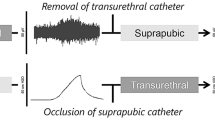Abstract
Purpose
Accuracy in the recording of external urethral sphincter (EUS) electromyography (EMG) is an important goal in the quantitative evaluation of urethral function. The aim of this study was to quantitatively compare electrode recordings taken during tonic activity and leak point pressure (LPP) testing.
Methods
Several electrodes, including the surface electrode (SE), concentric electrode (CE), and wire electrode (WE), were placed on the EUS singly and simultaneously in six female Sprague-Dawley rats under urethane anesthesia. The bladder was filled via a retropubic catheter while LPP testing and EUS EMG recording were done. Quantitative baseline correction of the EUS EMG signal was performed to reduce baseline variation. Amplitude and frequency of 1-s samples of the EUS EMG signal were measured before LPP (tonic activity) and during peak LPP activity.
Results
The SE, CE, and WE signals demonstrated tonic activity before LPP and an increase in activity during LPP, suggesting that the electrodes accurately recorded EUS activity during tonic activity and during the bladder-to-EUS guarding reflex, regardless of the size or location of detection areas. SE recordings required significantly less baseline correction than both CE and WE recordings. The activity in CE-recorded EMG was significantly higher than that of the SE and WE both in single and simultaneous recordings.
Conclusions
These electrodes may be suitable for testing EUS EMG activity. The SE signal had significantly less baseline variation and the CE detected local activity more sensitively than the other electrodes, which may provide insight into choosing an appropriate electrode for EUS EMG recording.




Similar content being viewed by others
References
Bradley CS, Smith KE, Kreder KJ (2008) Urodynamic evaluation of the bladder and pelvic floor. Gastroenterol Clin North Am 37(3):539–552 vii
Podnar S (2007) Neurophysiology of the neurogenic lower urinary tract disorders. Clin Neurophysiol 118(7):1423–1437
Mokhless I, Gaafar S, Fouda K, Shafik M, Assem A (2006) Botulinum A toxin urethral sphincter injection in children with nonneurogenic neurogenic bladder. J Urol 176(4 Pt 2):1767–1770
Bartkowski DP, Doubrava RG (2004) Ability of a normal dysfunctional voiding symptom score to predict uroflowmetry and external urinary sphincter electromyography patterns in children. J Urol 172(5 Pt 1):1980–1985
Koff SA, Diokno AC, Lapides J (1979) Neurogenic bladder dysfunction. Am Fam Physician 19(2):100–109
Sadoughi N, Bush IM (1974) Neuromuscular dysfunctions of the external urinary sphincter. IMJ Ill Med J 145(6):497–499
Thor KB, Katofiasc MA, Danuser H, Springer J, Schaus JM (2002) The role of 5-HT(1A) receptors in control of lower urinary tract function in cats. Brain Res 946(2):290–297
Damaser MS, Broxton-King C, Ferguson C, Kim FJ, Kerns JM (2003) Functional and neuroanatomical effects of vaginal distention and pudendal nerve crush in the female rat. J Urol 170(3):1027–1031
Kerns JM, Damaser MS, Kane JM et al (2000) Effects of pudendal nerve injury in the female rat. Neurourol Urodyn 19(1):53–69
Jiang HH, Gustilo-Ashby AM, Salcedo LB et al (2009) Electrophysiological function during voiding after simulated childbirth injuries. Exp Neurol 215(2):342–348
Jiang HH, Pan HQ, Gustilo-Ashby MA et al (2009) Dual simulated childbirth injuries result in slowed recovery of pudendal nerve and urethral function. Neurourol Urodyn 28(3):229–235
Chang HY, Havton LA (2008) Differential effects of urethane and isoflurane on external urethral sphincter electromyography and cystometry in rats. Am J Physiol Renal Physiol 295(4):F1248–F1253
Peng CW, Chen JJ, Chang HY, de Groat WC, Cheng CL (2006) External urethral sphincter activity in a rat model of pudendal nerve injury. Neurourol Urodyn 25(4):388–396
Shoffstall AJ, Zaszczurynski PJ, Butler RS, Damaser MS (2008) Development of a device to standardize leak point pressure experiments in rats. Neurourol Urodyn 27(6):553–558
Damaser MS, Kim FJ, Minetti GM (2003) Methods of testing urethral resistance in the female rat. Adv Exp Med Biol 539(Pt B):831–839
Ritter AB, Reisman S, Michniak BB (2005) Signal acquisition and processing. Biomedical engineering principles. CRC Press, Boca Raton, pp 265–289
Bennett BC, Kruse MN, Roppolo JR, Flood HD, Fraser M, de Groat WC (1995) Neural control of urethral outlet activity in vivo: role of nitric oxide. J Urol 153(6):2004–2009
Kruse MN, Belton AL, de Groat WC (1993) Changes in bladder and external urethral sphincter function after spinal cord injury in the rat. Am J Physiol 264(6 Pt 2):R1157–R1163
Soto E, Vega R (1990) Teaching field potentials: a microcomputer simulation of the nerve action potential in a bidimensional conductor. Int J Biomed Comput 26(3):211–220
King JC, Dumitru D, Nandedkar S (1997) Concentric and single fiber electrode spatial recording characteristics. Muscle Nerve 20(12):1525–1533
Acknowledgments
This work was supported in part by NIH RO1 HD38679-08, the Cleveland Clinic, and The Rehabilitation Research and Development Service of the Department of Veterans Affairs (M. Damaser). H.-H. Jiang was supported by the Society for Urodynamics & Female Urology and the AUA Foundation Scholarship Program.
Conflict of interest statement
There is no conflict of interest.
Author information
Authors and Affiliations
Corresponding author
Rights and permissions
About this article
Cite this article
Steward, J.E., Clemons, J.D., Zaszczurynski, P.J. et al. Quantitative evaluation of electrodes for external urethral sphincter electromyography during bladder-to-urethral guarding reflex. World J Urol 28, 365–371 (2010). https://doi.org/10.1007/s00345-009-0463-4
Received:
Accepted:
Published:
Issue Date:
DOI: https://doi.org/10.1007/s00345-009-0463-4




